The Claw. A karom.
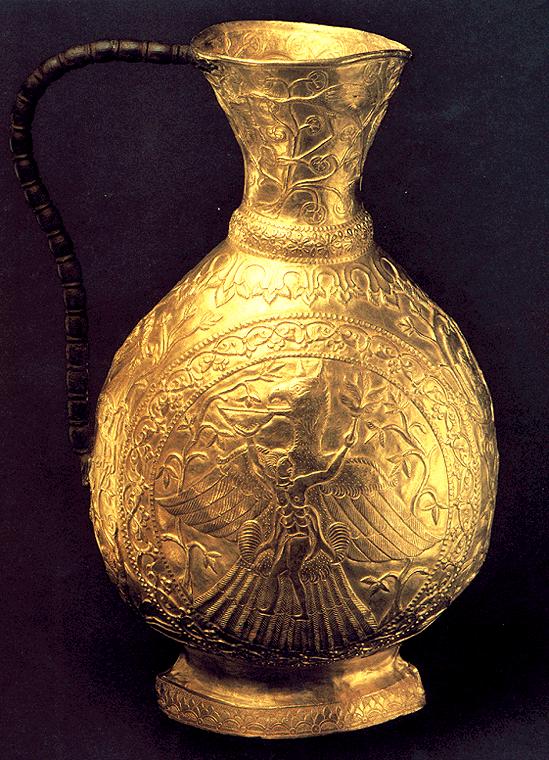 Újfalvy Károly
Újfalvy Károly
"The southern border mountains of Pamir-Garan, its holy fountains and altars, passages, pass-roads, paths, bridges, and ferries - Hot springs and geysers, earthquakes, metals, and minerals.."
"The main source of the Oxus or Amu Darya embraces Pamir like a mighty eagle's claw clutching its spoil. By Hara Berezaiti, or The High Mountain, the Iranian myths possibly mean Pamir, whence flows the Ardvisura (or Oxus), about which, according to the Iranian myths, was the garden of our first parents -- Airyana vaeja, in Avesta.
The Oxus receives its waters entirely from the glaciers and the perpetual snow of Pamir, and especially from the snow which falls here in winter, and drifts in the valleys. When the Oxus (Amu Darya) leaves the mountains, south of Samarkand, it receives the waters of no more tributary streams on its long course through deserts and steppes to the lake of Aral."
"The native Garans told us that many of the inhabitants live up on these terraces without ever descending the mountains ;"
"women wear chains round their necks, sometimes consisting of pieces of lapis-lazuli drawn on a string, but as a rule of stringed kernels of apricots "pyrk" )."
"In the platform to the right, in rare cases to the left, of the entrance is the hearth ("ghogof"), which consists of a cavity in the platform ending at the top in a small vetit for the smoke. In front of the platform is the fireplace, and below this in the floor are several ash-pits
("tokh")."
A finnugorászokat megvádoltam, hogy közük van az arvisurához. Pedig az őseik még a közelében sem járhattak az Ardvisura (Oxus, Amu-Darja, Hold-folyó, Jayhun) vizének... Aztán, ha már így előjött Turan vidéke, akkor meg kell említenem a tokárokat is. A nyugati
nyelvészet szerint a tokh jelentése ash-pits. Ami szerintük magyarul valami hamuval teli gödör... Nos, a magyarok valaha a Nílus partján is éltek. Ott meg rengeteg az "áspis". Nagyon alkalmas kígyófajta trükkök bemutatására. Ez nem a bUNGARus kerüleusz ! A NAJA (kobra) köpköd is! Szembe! Ne hagyjátok, hogy egy ilyen gerinctelen csúszómászó szemenköpjön titeket! Egy jól irányzott ütés... Mellesleg Egyiptom tengerparti városa TOKAR. A TOK egy turk szó, és "teli" jelentésű."Some of the fortresses on the northern bank of the Pandsh were now deserted and lay in ruins; but the fortresses of Kalai Sirgyn, by the kislak of Sirgyn, and Kalai Chiltak, west of Yemtshin, and Kalai Varang , by the kislak of Varang, were still occupied, and kept in a state of defence, and ready to check an advancing enemy"
"The household utensils were chiefly flat wooden dishes ("kobun") ; wooden bowls; large flat earthenware dishes ; earthenware bowls; earthenware pitchers of the same shape as those used in Scandinavia in olden time; low flat earthenware jugs for milk and water ("lubt") with a handle and a wide mouth ; rather large earthenware pots for the cooking of the food of exactly the same shape as our vessels of Jutland pottery "
"When I passed from Langarkish to Khorok the first time in 1896, there were no horses to be seen."
"the opium poppy ("kuknar"). This plant is very carefully tended, as many are addictedto the smoking of opium. Before the capsules get ripe, an incision is made into them with a knife, and the juice which comes out coagulates into a kind of resin which is scraped off and kneaded together into a dough (" afiun")."
"the common graves (gur, Persian for grave; guristan, the burial place) are often grouped round a so-called mazar. " (nem mizar!)
"There are several skies, one above another-the uppermost sky ("asman") is of silver and there Khoda (God) lives. In the earth lives the devil ("Shaitan") with all his brood "
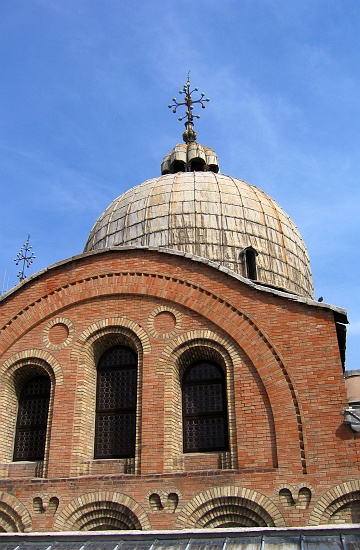 Pamir
Pamir
A sólyom karma
Magyar-finn
karom:
koura (fn) (átv)
kynsi (fn) (ál)
Spanyol szótár
karom {noun} garfa
(n)
karom {noun} garra (n)
karom (madáré) {noun} mano (n)
karom áll. {noun} uña (n)
olasz
nail:
1. chiodo
2. unghia
latin
unguiculus, i, hn. kics. sz. unguis,
köröm
(ember ujján v. lábujján); közm. ex unguiculis perpruriscere, minden izében;
unguis, is, hn.
1) köröm ujjon vagy lábon embernél, köröm, pata, karom, állatnál
Angol-francia szótár
claw/karom: griffe
Claw - gripp
Two formations: (1) OE. gripe str. masc., grasp, clutch, corresp. to OHG. grif-, in comb. (MHG. grif, mod.G. griff) grasp, handle, claw, etc., ON. grip-r possession, property; (2) OE. gripa handful, sheaf; both f. root of gripe. ON. had also grip neut., grasp, clutch (Sw. grepp, Da. greb). In some senses, the n. may be a mod. new formation from the vb. The instances of the word in the 15–17th centuries are chiefly Scotch, while examples in the 18th c. are very rare.
French: griffe. (Middle French < Old French < Latin gryphus, from Ancient Greek grúps.) Spanish: garra. Romanian: ghearä.
Portugál
claw garra
Alban
kthetër, thua, dorë {zhrg.}, darë {tek.}, panxhë {zhrg.}, putër {zhrg.}
Karom a szanszkritban
1.ardhacandanalipta mfn. half rubbed with sandal MBh. xiii , 888. candra m. half moon ; the semi circular marks on a peacock's tail L. ; the semicircular scratch of the finger nail L. ; an arrow, the head of which is like a half-moon MBh. R. Katha1s. (cf. %{ardhacandra-mukha} and
%{ardha@candrA7pama} below) ; the hand bent into a semicircle or the shape of a claw (as for the purpose of seizing anybody by the neck ; generally acc. %{-am} with 1. %{da} , to seize any one by his neck) Katha1s. Pan5cat. Vet. ; N. of the Anusva1ra (from its being written in the older MSS. in a semilunar form) Ra1matUp. ; N. of a constellation VarBr2S. ; (%{A}) f. the plant Convolvulus Torpethum ; (mfn.) crescent shaped , of a semilunar form Hcat. ; (%{ardbacandra}) %{-kuNDa} n. N. of a mystical figure of semilunar form ; %{-bhAgin} mfn. seized by the neck ; %{mukha} mfn. (an arrow) the head of which is like a half-moon Ragh xii , 96 ; %{ardhacandrA7kAra} or %{ardhacandrA7@kRta} mfn. half moon shaped, crescent shaped, %{ardhacandro7pama} mfn. `" like a half-moon "' , of semilunar form (said of an arrow , the head of which is like a half moon) R.
2 ardhendu m. (%{-ardha-candra} above) a half moon or crescent Naish. ; the semicircular impression of a finger nail L. ; an arrow with a crescentshaped head L. ; the hand expanded in a semicircular from like a claw L. ; the constellation also called %{ardhacandra} (q.v.) VarBr2S. ;
(%{ardhe7nd}) %{-mauli} m. `" whose diadem is a half-moon , S3iva Megh. Ba1lar.
6 nakha m. n. (fr. %{nagh} cf. %{naghamAra} ; prob. not fr. %{na} + %{kha} in spite of Pa1n2. 6-3 , 75 ; ifc. f. %{I}) a finger-nail , toe-nail , claw , talon , the spur of a cock RV. &c. &c. (%{-khAni-kR} , or %{klRp} , to cut the nails Kaus3. Mn.) ; = 20 Su1ryas. ; n. and (%{I}) f. Unguis Odoratus VarBr2S. Hcat. ; m. part , portion. {Cf. Gk. $ , stem $ ; Lat. &162290{524 ,3} {unguis} ; Lit. {na4gas} ; Slav. {nogu8ti8} ; Angl. Sax. {naegel} ; Eng. {nail} ; Germ. {Nagel}.
Nefrit karom
Note the golden spangles and the comma-shaped jade ornaments, which are called kog'ok in Korean and magatama in Japanese.
Macskakaroma gyógyításban.
- csökkenthetjük a rákos megbetegedések kockázatát
- védekezhetünk különböző mérgek és toxinok ellen
- erősíthetjük immunrendszerünket, hogy hatásosabban küzdjön a vírusok és bakteriális betegségek ellen, amelyeken a gyógyszeres kezelés nem segít.
- lehet megelőzni a korai öregedést, a degeneratív betegségeket, az ízületi fájdalmat, a szívbetegséget vagy az agyvérzést.
Mint a torony 30 m magasra is felfut
Common Names: "cat’s claw", "Peruvian cat’s claw", "hawk’s claw". Castilian/Spanish: Peru "uña de gato", "uña de gato roja"; Loreto "garabato colorado"; Ucayali "uña de gato de altura", "garabato amarillo", "bejuco de agua"; San Martín "garabato"; Others "paraguayo", "garabato", "garabato casha", "samento",
"toroñ", "tambor huasca", "uña huasca", "uña de gavilán", "garra de gavilán", "saventaro", "soga de agua",
"vilcacora". Asháninka: kug-kukjagui. Portuguese: "deixa paraguayo". Others: "unganangui", "uncucha", "tsachik", "paotati-mösha", "misho-mentis",
"jipotatsa", "torõn".
..altera pars
Etymology : Uncaria comes from the Latin word "uncus", which means hook; all species from this genus have hook-like thorns. Tomentosa means "covered with fine hairs"; the leaves of this plant present these fine hairs. Kár, hogy az UNCARIA már maga latin, tudományos név. Ugye, mint feljebb látjuk, számos néven jelölik a különböző népek a növényt.
* Az eset hasonlít a KRAIT kígyó tudományos nevéhez: Bungarus keruleus. Magyar rendszerbe foglaló? Vagy csak ismerte a magyarokat? (Távolkeleti "arany" és latin "kék"!)
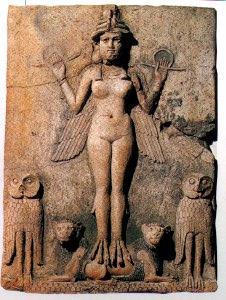 Érdekességnek: - PERSI
Érdekességnek: - PERSI
Karom
Pskov's Kremlin (Krom) The best way to get to know the ancient city is to begin at the very spot where the city itself began - at its original for-tress, the Krom.
Amazon
It was called Pershi or Persi, from the old Russian word "persi", meaning "chest".
Ukraina
Ukraina, lit. "border, frontier," from u- "at" + krai "edge."
Ta Krai is a khum (commue) of Kamrieg District i
Battambag Provice
Malájföldön pedig Kuala Krai található Kelentan tartományban.
Krait(krīt)
any of a genus (Bungarus) of SC and SE Asian elapine snakes that are generally black or dark brown with tan or yellow bands
Orosz
In Russia, krais were historically vast territories located along the periphery of the country.
Since the word "krai" also means "border" or
"end", it is used to describe regions located along the economic and geographic periphery. The words Ukraine and Ukrainian incorporate "krai"
within them.
Krait: kígyófajta (bungarus), amely Pakisztán, India, DK-Ázsia területén található.
Hindu és urdu területen karait a neve.
Kisoroszország
THE IDEA IN THE WORD UKRAINE
CONVEYS CONCEPTS OF " NO MAN'S LAND "
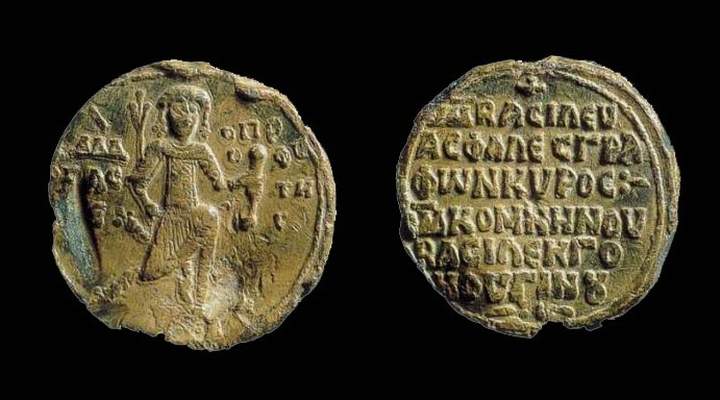 ukr U and KRAI = BORDER and COUNTRY
ukr U and KRAI = BORDER and COUNTRY
KRAI TO CUT AREA ZONE
ukr RUS ANCIENT NAME FOR UKRAINE
taken up by
MOSCOW or MOSCO or MUSCOVY
RUSIN A SLAV
lat RUTHENI same
RUTHENIA ancient NAME FOR UKRAINE and
CURRENT NAME FOR WESTERN UKRAINE
Edge
A KRAI több jelentésű szó. Leggyakoribb azonban valaminek a széle, pereme. Pl. krai stola = az asztal széle, vagy krai sveta= a falu pereme. xrai {krai}= upper part = felső rész, kopt nyelven.
Az első krimi
"Latin origin: 'corvidae', all raven-birds, e.g.:'corvus corax'
English: raven, Holland:
raaf, Német: Kolkrabe, Swed.: korp; 'corvus (corone) corone': E:
'carrion crow', D: 'zwarte krai', LS: 'Krai', G: 'Rabenkrähe', Swed.: 'swart kråka' etc..."
...és a RABONBÁN:
"The Modern Low Saxon words are _rave_ {'rQ:ve} ~ {'rQ:be} and _raav'_ {rQ:.v} ~ {rQ:f} ~ {ro:f}, going back to Old Saxon _hravan_; cf. Old Low Franconian _raven_ (>
_raaf_), Old English _hræfn_ (> raven), Old German _raban_ ~ _rabo_ (> _Rabe_), Old Norse _hrafn_ (~ _korpr_!), Gothic
_hrabns_, < Germanic *_hrabna_."
Érdekességek:
Köröm, karom
"the entry for noga says "ORIGIN: native {Slavic word}, with original meaning 'claw'".
(ak)Nogay tatárok egy fórumról:
"What is the Kurdish for "nail"? Slavic "noga" seems to be comparable with the Persian word for "nail" i.e. nâxon (nâkhon). "...és a róka: "Raka/(kéz) cognate with Slovene roka comes from PIE *uronkaH"
"Shapka (Russian (шапка), from the Russian language word for "hat") A Ushanka." (Valójában a szibériai sámán fejfedője a SAPKA, de még ez sem az eredeti etimológia..)
"Tsar also Czar, Tzar, Csar, and Zar (Russian: царь) (English pronunciation {zar}; Russian pronunciation is {ʦar;}) (Russian tsar from Latin Caesar "hairy") 1. (historical) Title of a Southern Slav ruler as in Bulgaria (913-1018, 1185-1422, and 1908-1946) and Serbia (1346-1371). 2. (historical) Title for the emperor of Russia from about 1547 to 1917, although the term after 1721 officially only referred to the Russian emperor's sovereignty over formerly independent states."
"Rabat's history began with a settlement, known as Chellah on the banks of the Oued Bou Regreg in the third century BC. In 40 AD, Romans took over Chellah and converted it to the Roman settlement of Sala Colonia. "
Chellah szó nagyon hasonlít a holland claw/karom=chela szóra.
I'm told
my family name is written as Χελενττζαρις
My relatives here have suggested that it might mean something to the effect of "rules/ruler by the claw", from "claw=chela" and
"tsaris"-->tsar/caeser = ruler.
Latin ungius
Italian unghia
Catalan ungla |
Spanish uña
French ongle ( ɔ̃gl)
Provencal ongla |
Romansch ungla
Friulian ongule
Rumanian unghie |
Classical Armenian magil
Armenian List ełungn
Armenian yeghung |
Tocharian A maku
Danish "negl =claw".
Marwari nūṃ |
|
Köröm, karom
tooth and nail =
δόντι και καρφί (greek) /donti kai karfi=foggal körömmel/
nail = unghia (italy)
In Dari (the Afghan variant of Farsi) nakhun is sometimes used to refer to nail or finger .Siam (ma Thailand) területén számos NAKHON található. Ők "város"-nak vélik...
Ha a kurd çeng = claw = karom, çengel = hook = kampó szavakat nézzük, akkor a Brahmaputra (Tsango-Po) mellől érkező népet csengel-nek is nevezhetjük.
Garifalo és a noga(y)
The name clove, as well as Spanish clavo, Catalan clau, Portuguese cravinho and Tagalog
clovas, ultimately derives from Latin clavus nail {karom, köröm} (because of shape
resemblance).
The word made its way into English via Old French clou. The word clove is related to the verb cleave (which is what you can do with a nail) and therefore also to clove as in a clove of garlic. See there for further connections of clavus.
Most Germanic and Germanic-influenced tongues have a different word for clove: German Nelke, Norwegian nellik, Danish nellike, Icelandic negull, Swedish neijlikor, Yiddish negelen {נעגעלען}, Finnish neilikka, Estonian nelgi and Sranan
nagri.
These are related to German Nagel, nail. A modern olaszban a KAROM az unghia.
Nail and its cognates
in Germanic languages (Old High German nagal, English nail, Icelandic nagli, Swedish nagel) basically means either "nail of finger or toe" or "slim pointed piece of metal"; the second meaning is younger and does not appear outside the Germanic languages: Old Irish ingen, Latin unguis "nail", Latvian nags "hoof", Greek onyx /harpáge/ {ὄνυξ} claw, Sanskrit anghri {अंघ्रि} "foot". The vower variations made reconstruction of the Proto-Indo-European root behind all these forms
somewaht difficult, but laryngal theory suggests H₃NOGʰ or H₃N̥Gʷʰ (with possible extensions) nail, claw as a reasonable guess.
Clove
Cloves are named "nail spice" in other languages, too; for example, in Western to Central Asia, one finds a group of related names: Farsi میخک Mikhak. Tamil கராம்பு,
கிராம்பு
Graambu, Krambu, Karambu, Kirambu.
The name clove, as well as Spanish clavo, Catalan clau, Portuguese cravinho and Tagalog clovas, ultimately derives from Latin clavus "nail" (because of shape resemblance).
Western to Central Asia: Georgian mikhak’i [მიხაკი],
Azeri mixək and Farsi mikhak [میخک] belong to the same kin as Azeri mıx and Farsi mikh [ميخ]
"nail". Similar names for "nail" are found in several Turk languages (Turkish mıh and Uighur mih), suggesting that the name is ultimately of Altaic origin.
Ez alapján pedig
Istanbul - a viking Mikligardur - a KAROMVÁROS. Ahol a cár székelt, miután Caricinból oda költözött. A CÁR nem azonos a semita SAR (uralkodó) szóval, hanem szintén KAROM jelentésű. /carapat/.
Orosz szótár:
царапать /carapaty/ karcolni
царапать(ся) karmolni
Persze, ha MIKILgardur lett volna Bizánc, akkor csak egyszerűen NAGYváros az északi név. Érdekességként megjegyzem, hogy a tochar "mäk=sok", mint a mákszem a gubóban.
Pokorny
Root: onogh- (: ongh-, nogh-; kelt. n?gh-), ongh-li-
English meaning: fingernail, claw
русская шапка Шапка (фр. chape
от лат. cappa — головной убор)
Géza - a karom terület feje ?
It has been proposed on the basis of phonetic similarities that the name Gesar reflects the Roman title Caesar, and that the intermediary for the transmission of this imperial title from Rome to Tibet may have been a Turkish language, since kaiser (emperor) entered Turkish through contact with Byzantium, where Caesar (Καῖσαρ=kajszar) was an imperial title. Some think the medium for this transmission may have been via Mongolian Kesar. The Mongols were allied with the Byzantines, whose emperor still used the title. Numismatic evidence and some accounts speak of a Bactrian ruler Phrom-kesar, specifically in the Turkish dynasty in Gandhāra, which was ruled by a Turkish Phrom-kesar ("Caesar of Rome"), who was father-in-law of the king of Khotan, around the middle of the 8th.century CE. In early Bön sources, Phrom-kesar is always a place name, and never refers, as it does later, to a ruler. In some Tibetan versions of the epic, a king named Phrom Ge-sar or Khrom Ge-sar figures as one of the kings of the four directions - the name is attested in the 10th century CE and this Phrom/Khrom preserves an Iranian form (*frōm-hrōm) for Rūm/Rome. This eastern Iranian word lies behind the Middle Chinese word for (Eastern) Rome (拂菻:Fúlǐn), namely Byzantium (phrōm-from<*phywət-lyəm>).
Körömszakadtáig
"Origin:
bef. 900; (n.) ME nail(l), nayl(l), OE nægl, c. OFris neil, OS, OHG nagal, D nagel, G Nagel, ON nagl fingernail, all < Gmc *naglaz; akin as deriv. to Lith nãgas, nagà hoof, OPruss nage foot, OCS noga leg, foot (Serbo-Croatian nòga, Czech noha, Russ nogá; prob. orig. jocular reference to the foot as a hoof), OCS nogŭtĭ, Tocharian A maku, B mekwa fingernail, claw, all North
European IE *Honogwh-; further akin to OIr ingen, Welsh ewin,
Breton ivin , Celtic *ṇgwhīnā, L unguis , Italo-Celtic *Hongwhi-; Gk ónyx, s. onych-, Armenian ełungn , *Honogwh-; (v.) ME nail(l)(e), nayl(l)e(n), OE næglian, c. OS neglian,
OHG negilen, ON negla , Gmc *nagl-janan; cf. Goth ganagljan"
Timaru-Kast
A Jóanya / Istenanya törzse
A Honfoglalás Könyve szerint Míl hét (késöbb nyolc) 'fiúnak' az apja. Míl népe hét
törzs szövetsége és ő e törzsszövetségnek a vezére. Megválasztásakor -kelta szokás szerint- pajzsra emelték. Nem ismerjük Míl népe vezéreinek nevét, de a Honfoglalás krónikája megörökítette ezek feleségéinek nevét: Tea, Fial, Fás, Liben, Odba, Scota és Scéne.
Fintan hét honfoglalásra emlékszik.
Először ám elmeséli Írország földjének első felosztását. Ui Neillék egyszer gyűlést (szert) tartottak Magh Bregh ("Pusztamező")-nél. Itt az egybegyűltek megegyeztek abban, hogy Tara, a főváros, helyzete nem előnyős, mert habár egy síkságon fekszik és innen hét irányba lehet látni, nincs rajta egy méltó udvarház sem, ami háromévenként megvendégelhetné Írország összes férfiát és asszonyát.
Danu nevét ellenben továbbéltették DON-nak keresztelt folyóikban (Írországban, Skóciában, Angliában, de még Galliában is). Ők voltak a "druidák (tordák) népe" és a "griffes-indás" művészet megalkotója. Ők, a bölcsek, akik olyan hatalmas tudással rendelkeztek, hogy "talán egyenesen az Égből jöttek" az ír szigetre, akik a Duna partján keresték és elérték a tudás, a bölcsesség, a jóslás és a költészet legmagasabb fokát, az ÉICSE-t (azaz az ÉSZ-t). Ez a honfoglaló hullám lehetet az, amely az ír nyelv fejlődését is nagymértékben meghatározta. A magyar nyelvvel kapcsolatban ugyanez elképzelhető a "griffes-indás" telepesekről is, akik Magyarországon mindennek nevet adtak és meghatározták a Kárpát-medence, az Árpád vezette
"magyarnak" nevezett Honfoglalás előtti időkből származó, földrajzi (hegy- és vízrajzi), valamint helységnevek zömében magyar jellegét.
Seres
Georgius Eremita szerint: Ser a tibetiek által hivatik Chinának. Innét lehet megérteni, hogy azok, kiket a legrégibb földleirók Seresnek hívtak, miért
neveztettek az indok, persák s araboktól Kin, s azután Sin névvel. Mert Ser szó tibet nyelven ugyanazt jelenti, mint Kin chinai nyelven; jelent t.i. mindkettő aranyat. A rómaiak a selymet Sericumnak azért nevezték, mert ez a Seres nép földéről került hozzájok.
Mondjuk, nekem csak a kurd "ser=oroszlán" rémlik, meg valami semita nyelven a "ser=head". Így aztán Serindia lehet "Oroszlános India" vagy "India-fő". Mint látjuk Gyárfás Istvánnál ez "Aranyos India". Mondjuk, a mongol "sera=hold" után "Holdas-India is lehetne... vagy a "serica=selyem" alapján Selymes-India..
Romák
romach: a spear, lance
Original Word: רֹ֫מַח
Part of Speech: Noun Masculine
Transliteration: romach
Phonetic Spelling: (ro'-makh)
Short Definition: spears
Karom
Greek ἔτυμον (étymon, the true meaning of a word)
Fűszer
The botanical genus name Syzygium derives from Greek "syn = together, with" and "zygon = yoke" (from "zeugnynai = join").
Old Irish ingen, Latin unguis "nail", Hebrew tsiporen also has two meanings "fingernail" and "clove", Greek garifalo "clove", Kazakh qalampir, Bulgarian karamfil, Pashto and Urdu lung, Bengali labango.
HAND
(1) Akk. kātu // No Sem. etymology. (Átvétel a mag néptől?)
(□ If t- is a fossilized suffix, related to Afras. *ḳaVw/y- 'claw, fingernail, hand' (ADB): Chad. W.: Mburku ḳawi, Jimbin ḳuya 'finger-nail', E.: Ubi kòyà 'hand', Mokilko
kóokè (redupl.) 'claw'; E. Cush.: Konso kayaa, Darasa ḳeʔya
'claw', Gawwada qoy-akko 'claw, nail', Dobase qo-akko 'finger', Tsamay go-akko 'claw, hoof'; perhaps also Egyp. (MK) ḳḥ '(upper) arm, shoulder, elbow' without reliable Afras. parallels10, implying that Egyp. ḳḥ may be a result of secondary phonetic processes, considering that the combination *ḥ is impossible in Sem. and unusual for Afras.
(2) Ugr. yd; Hbr. yād; Pho yd; Bib. yad; Pal. yaḏ, ʔīḏ; Syr ʔid; Mnd. (i)d; Urm. ʔayd; Qur. yad; Leb. ʔ$d; Mec. yad; Mlt. idey; Sab. yd; Gez. ʔ$d; Tna. ʔid; Tgr. ʔ$de; Amh. ʔ$ǯ; Arg. $nǯ;
Sod.
A "szív" etimológiáját is olvassátok el! Vagy a "máj" szavunk eredetét...
Szív: Akk. libbu; Gez. dömāh, d$mā, d$māh 'head, crown of the head, skull, summit',
Chad. *kwad-/*kwaḍ-; Akk. dâku/ duāku 'to kill'
Hrs. yōda "know"; Sem. *ḥkm 'to know, be
wise' hakim
Emir? Ugr. ʔamr 'to look at'; Beja mir 'see, attend to; find',
Kalapács, a lopótök kulacs
Tokaj, Somló, Badacsony, borral töltsd a kulacsom
Rendille
kul, pi. kulal "calabash (of wood)" [Heine 1976, 213] - kul "long-necked container
A KAROM
A hun CÁR nevének eredete
(Kocsi nem csak a Kárpát-medencében van! Nagy város Japánban és Indiában. Karpat az O.Ir. nyelven kocsi.)
Korean: *koč = claw /karom
Meaning: 1 to scrape 2 claw, finger-nail Russian meaning: 1
karmot, karma, karmok} 1. (állaté) коготь kogoty
(ember körme) коготь;3. átv. коготь, лапы
karcolni царапать CARapaty
karmolni царапать(ся) CARapaty(szja)
English meaning: nail, fingernail, claw/karom
German meaning: Nagel,
Klaue
Finnish: kynsi (kynte-, gen. kynnen) 'Nagel, Klaue, Kralle; Zinke, Zacke'
Estonian: küüs (gen. küüne)
Saam (Lapp): gâʒ'ʒa -ʒʒ-
(N) 'nail; claw', kaddsa (L), kanc (T), kønc (Kld.), køcc (Not.) 'Klaue, Nagel'
Mordovian: kenže (E), keńžä (M) 'Klaue, Nagel, Huf'
Mari (Cheremis): kǝč (KB), küć (U), küč (B)
Udmurt (Votyak): gi̮ži̮ (S), gǝ̑žǝ̑ (K) 'Nagel, Kralle',
gižị̑ (G) 'Nagel, Klaue'
Komi (Zyrian): gi̮ž (SP) 'Nagel (an Fingern, Zehen), Klaue, Kralle', gøž (PO)
Khanty (Ostyak): kö̆ṇč (V), kŏṇč (DN), kus (O) 'Nagel, Klaue'
Mansi (Vogul): künš (TJ), koäš (KU), käš (P), kos (So.)
Nenets (Yurak): ẋada (O) 'Nagel, Kralle'
Enets (Yen): kóra (Ch.), kóda (B)
'Nagel'
Nganasan (Tawgi): kátu
Selkup: k↔ Omotic: *guš- 'fingernail, claw'
Mint látjuk, a koreai "karom" igen hasonlít a cseremisz "karom" szóra. Finnugor népek, ha találkoznak..
Ar.; gard "dust," Mid.Pers. gart,
gard.
A felsorolás közel sem teljes! Gondoljunk csak KRUM/Karom kán nevére a bulgaroknál vagy a CROM kelta szóra a skótok felé. Egyesek szerint a NOGAY (tatár) is KAROM elentésű.
Latin szótárból:
Seres, rum, hn. t. {= Shres}
nemzet keleti Ázsiában. Innen Sericus, mn. gyakran selyem-; s így mint fn. -ca, orum, kn. t. selyemszövetek és -gunyák; carpentum s., selyem függönyökkel; és Serici, orum, hn. selyemkereskedő (ez utóbbi két szó így is: Siricae, arum, nn. és Sirici).
zhuă - claw - karom (kínai)
Saskarom
Szécsény
"The quake destroyed our houses and fields.
Most of us cannot return to the mountains," sighs Jia, a Qiang official in Qushan Town, Beichuan County.
Claw of Archimedes
"The Claw" redirects here. For the vending machine, see Claw vending machine. The Claw (Greek: ??????, harpáge, "snatcher") of Archimedes was an ancient weapon devised by Archimedes to defend the seaward portion of Syracuse's city wall against amphibious assault. Although its exact nature is unclear, the accounts of ancient historians seem to describe it as a sort of crane equipped with a grappling hook that was able to lift attacking ships partly out of the water, then either cause the ship to capsize or suddenly drop it.
Macskakarom
Uncaria tomentosa (Cat's Claw)
Cat's claw, an herb found in a limited region of the upper Andes in Peru
Common Names: "cat’s claw", "Peruvian cat’s claw", "hawk’s claw". Castilian/Spanish:
Peru "uña de gato", "uña de gato roja"; Loreto "garabato colorado"; Ucayali "uña de gato de altura", "garabato amarillo", "bejuco de agua"; San Martín "garabato"; Others "paraguayo", "garabato", "garabato casha", "samento", "toroñ", "tambor huasca", "uña huasca", "uña de gavilán", "garra de gavilán", "saventaro", "soga de agua", "vilcacora".
 Fehér király
Fehér király
A Fir Bolg honfoglalása egy külön érdekes motívum, ugyanis egy király (Dela) öt fia (Slainge, Rudraige, Gann, Genann és Sengann) három csoportra oszolva szállt partra Írországban, és Tarában találkoztak, miután öt részre osztották föl a királyságot. Az ír szó a megyére, vagy
tartományra, a cúige, ötödöt jelent. A központi terület Meath (Míde) volt (neve középsőt jelent), és a fővárosa Tara, mint a királyok székhelye.
Korábban Tara királyai talán csak a központi törzs királyai voltak, azonban a történetekben Tara szerepe úgy tűnik fel, mint a Főkirályok
(ard-rí) székhelye.
A Kr.u.V.sz. előtti ír állapotokról nagyon keveset tudunk. Mac Neill szerint a korai hatalmi rendszer az ún. pentarchia volt, azaz Írországot öt részre (cóiceda, a mai ír cúige, 'tartomány' jelentésű szó) osztották fel
Így tűnt el a Kr.u. V.sz.-ra a moccu terminus, amely a törzsi rokonságot jelölte, és új fogalmak jelentek meg: Uí ('unokák' ujj?), Cenél ('rokonság'), Clann ('család, gyermekek') és Síl ('leszármazott').
Ekkor került az Uí Néill uralma alá a Bann folyótól nyugatra és a Moyola folyótól északra eső terület (Mag Dola, Derry délkeleti részén), míg a Bann folyótól keletre a Dál nAraidi maradt hatalmon.
A sasnak körme között
Köröm
the bizarre and disturbing custom of binding the feet of women began, an affectation, as with the long fingernails of the Mandarin bureaucrats, to display one's freedom from physical labor.
"Tartar" is a European rendering of Persian Tâtâr. The extra "r" seems to have crept in from Greek/Latin Tartarus, the deepest region of Hades, i.e.
Hell. This reflects the judgment that the Tartars were like demons from Hell
Neill
The Uí Neill and the High Kings
Ulster and Mide
Serie
Kína
Eagle Claw (ying quan ) is one of the oldest wushu styles known and has its origen in Henan. Like all the northern wushu styles, eagle claw involves long strikes an kicks which is typically. But
this style is also influenced by Chin Na, an ancient chinese grappling system.
Egyiptom
This god war falcon is shown in a boat, and he reigned in the province of 12th district of Upper Egypt. Nicknamed the claw, the adepts of his ancient cult gave him a twin brother : the falcon god Nemty (the name means: one who journeys), who by contrast with his twin is usually represented perched on a shield.
Tutankhamonékszerei mennyire hasonlítanak a magyar-gót
ötvösművészetre...
Claw
On the upper RH side is shown marshland, denoted by six papyrus plants topped by a falcon that symbolises the king. With its claw, the falcon appears to be drawing the "life" out of the mouth of the marshland's "face".
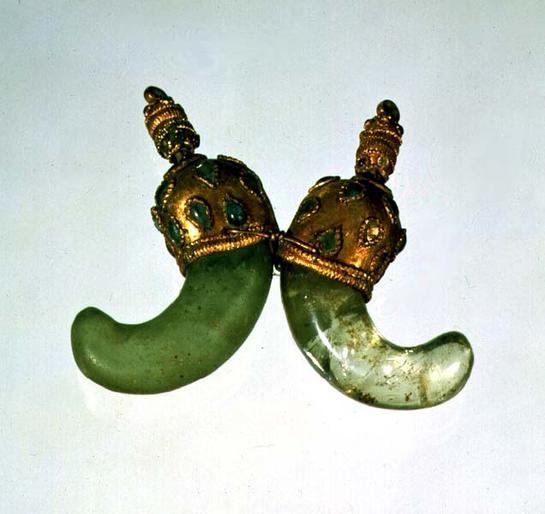 Karom
fülbevaló
Karom
fülbevaló
Note the golden spangles and the comma-shaped jade ornaments, which are called kog'ok in Korean and magatama in
Japanese.
Kard a kés (a perzsában)
Zahi Hawass egyiptológus említi, hogy a 18. dinasztia új fegyvereket kapott a hyksosoktól cca. Kr.e. 1600 táján, többek között egy kardszerű fegyvert is, a "scimitar"-t. De a névhasználat téves lehet: A scimitar eredetileg a perzsa shamshir szóból származik, amely oroszlánköröm jelentésű.
A kard szinte egész Belső-Ázsiában és Dél-Ázsiában egy görbe, ívelt penge, mint
a magyar szablya. Ilyen az arab saif, az indiai talwar, a perzsa
شمشیر shamshīr és a török yatağan.
Sher,
shir = lion/oroszlán
Serindia = Oroszlános India
Shamshir = oroszlánköröm
Az új világatlasz már nem jelzi a Mongólia
északi részén húzódó falat. Gondolom, hamarosan a Gorgan fal is hasonló sorsra jut. Mert nehéz megmagyarázni, hogy miért voltak a hunok bekerítve magas
fallal. Ha nem ők építették... Shambhala... a bekerített álomország. (Tibeti kultúrkör)
Érdekességnek: A SHAMAN szót egyesek MANCHU szónak mondják, s "tudós" jelentést adnak neki. Nos, nálam a SHAM az óperzsa KAROM.
Tükrözések
German: Krummsäbel - French: cimeterre
Danish: krumsabel - Italian: scimitarra
Dutch: kromsabel - Spanish: cimitarra
Scottish Gaelic: claidheamh crom
Shabe
SHAB-E YALDA
The Eve of the Birth of Mithra, the Sun God, celebrated on 21 December.
ShebaThis name Sheba is according to Jones comparable with an Ethiopian
word meaning `man'.
The first Sheba-with-aleph mentioned in the Bible is a son of Raamah, son of Cush, son of Ham, son of Noah. Another Sheba is a
son of Joktan, who is the brother of Peleg
This name Sheba is identical to the words sheba, meaning seven and shaba, meaning to swear (an oath).
Szombat Shiva is the Lord of the Sabbath. Shiva as Lord of Yoga, Fulfilling the
Seven Chakras Shiva meant Seven throughout the Ancient World. The Ancient Hebrew word Shabbath, meaning Sabbath, Has its roots in Sheba meaning seven, and
Shaba.
Krumm kán German: nickname from Middle High German krum ‘crooked’,
‘deformed’; it may have been applied in the literal sense to a hunchback or cripple, but equally it may have denoted someone who was ‘bent’ in the abstract
sense, i.e. ‘dishonest’ or ‘false’.
..the German krumm, crooked, bent, or Norwegian, krum, meaning the same thing.
garra - "Definitions: claw." Spanish)
shqer ‘karmolok’ albán ; zgâria ‘karmolok’ román
Karom
án: Nagy Károly halála i.sz. 1004.! (AD 814) Krum/Karom kán halála is. Tar-kán vagy Tar Zerind menti a menthetőt, magállítja a karoling és a felbátorodott
szláv terjeszkedést. Fiai alatt (Géza, Koppány, és a Bizáncban megkeresztelkedett Mihály) erőrekap országunk, amelyet a nyugatiak csak Bulgáriának látnak, részben jogosan, mert nem lehet megmondani, hogy hol húzodhatott a határ köztük és Omortág Bolgáriája között.
Árpád
Csoda, hogy madarnak nézték?..
Péter Katalin: Azt szoktam mondani, ha kérdeznek, hogy egy gyermekkori élmény hatása alatt lettem történész.
"ha történetesen nem sokkal késõbb az iskolában nem tanultunk volna az Árpád-házról. Meglepõdtem,mert Cseh bácsi,a tanítónk nem beszélt arról,hogy az Árpádok egyik kezén,két ujjuk között sas karom volt.Én viszont tudtam. Makkai könyvében olvastam róla."

Macskakarom/ Sólyomkarom
Latin név: Uncaria tomentosa
Termése 3 ágú |
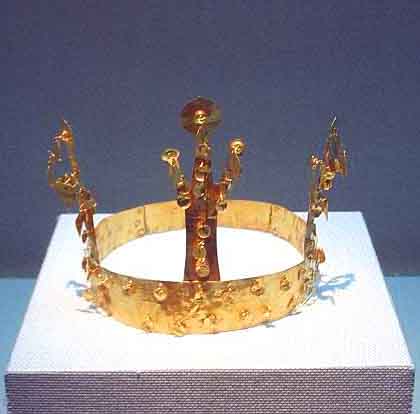 A korona 3 ágú, mint a Cat' /Hawk/ Claw termése. |
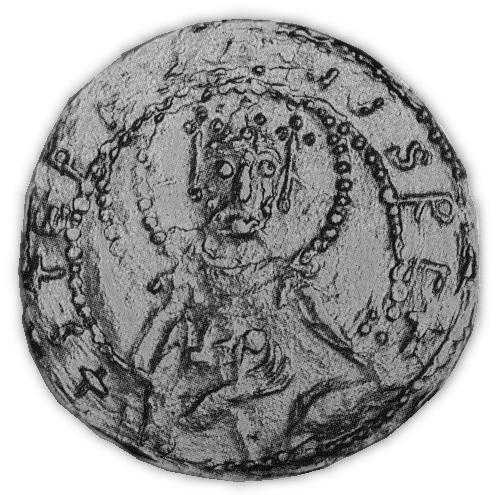 Az érme feltehetően a 11.sz. végén készült és Szt Istvánt ábrázolja 3 ágú koronával. |
Pesti István 2009 február
Nyitóoldal
 Fehér király
Fehér király Karom
fülbevaló
Karom
fülbevaló


 Újfalvy Károly
Újfalvy Károly Pamir
Pamir Érdekességnek: - PERSI
Érdekességnek: - PERSI ukr U and KRAI = BORDER and COUNTRY
ukr U and KRAI = BORDER and COUNTRY